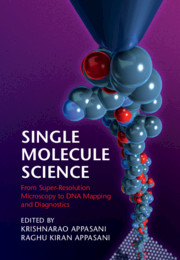Book contents
- Single-Molecule Science
- Single-Molecule Science
- Copyright page
- Dedication
- Contents
- Contributors
- Foreword
- Preface
- Part I Super-Resolution Microscopy and Molecular Imaging Techniques to Probe Biology
- 1 Introduction on Single-Molecule Science
- 2 One Molecule, Two Molecules, Red Molecules, Blue Molecules
- 3 Multiscale Fluorescence Imaging
- 4 Long-Read Single-Molecule Optical Maps
- Part II Protein Folding, Structure, Confirmation, and Dynamics
- Part III Mapping DNA Molecules at the Single-Molecule Level
- Part IV Single-Molecule Biology to Study Gene Expression
- Index
- References
4 - Long-Read Single-Molecule Optical Maps
from Part I - Super-Resolution Microscopy and Molecular Imaging Techniques to Probe Biology
Published online by Cambridge University Press: 05 May 2022
- Single-Molecule Science
- Single-Molecule Science
- Copyright page
- Dedication
- Contents
- Contributors
- Foreword
- Preface
- Part I Super-Resolution Microscopy and Molecular Imaging Techniques to Probe Biology
- 1 Introduction on Single-Molecule Science
- 2 One Molecule, Two Molecules, Red Molecules, Blue Molecules
- 3 Multiscale Fluorescence Imaging
- 4 Long-Read Single-Molecule Optical Maps
- Part II Protein Folding, Structure, Confirmation, and Dynamics
- Part III Mapping DNA Molecules at the Single-Molecule Level
- Part IV Single-Molecule Biology to Study Gene Expression
- Index
- References
Summary
More than 150 years after the discovery of DNA (Dahm, 2005) and 50 years after the determination of a DNA duplex structure (Choudhuri, 2003), our understanding of genomics is still lacking. Despite a massive effort in genetic studies, there are still missing pieces in the puzzle: many traits have no corresponding genetic features, the reasons for variations among different individuals within a species are still a mystery, and the lack of single-molecule resolution hinders many types of analysis. These gaps are exemplified by inherent limitations in the currently leading technique for DNA studies, next generation sequencing (NGS). The initial “input” for NGS consists of genomes extracted from a large number of cells, and the final “output” is a single sequence. Thus, the produced data represents an average sequence of the majority of the sequenced cells. This results in oversight of several significant biological aspects, since variations within the population and rare cellular populations are not detected.
- Type
- Chapter
- Information
- Single-Molecule ScienceFrom Super-Resolution Microscopy to DNA Mapping and Diagnostics, pp. 49 - 64Publisher: Cambridge University PressPrint publication year: 2022

